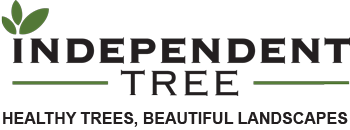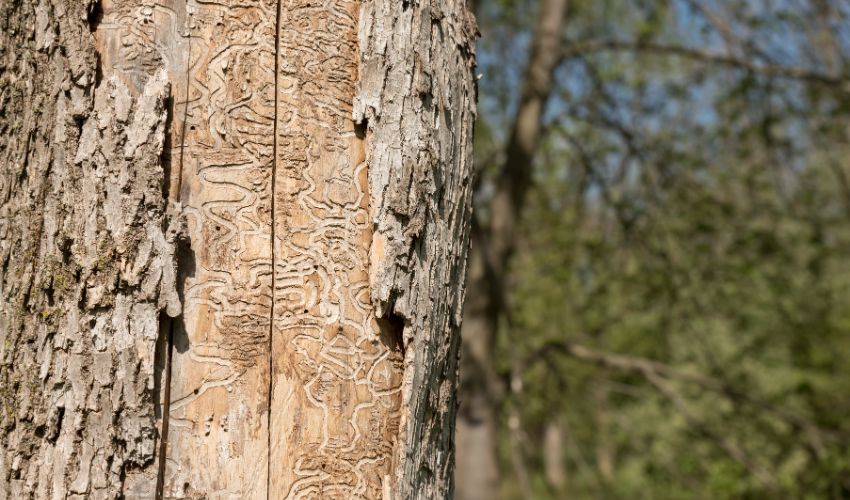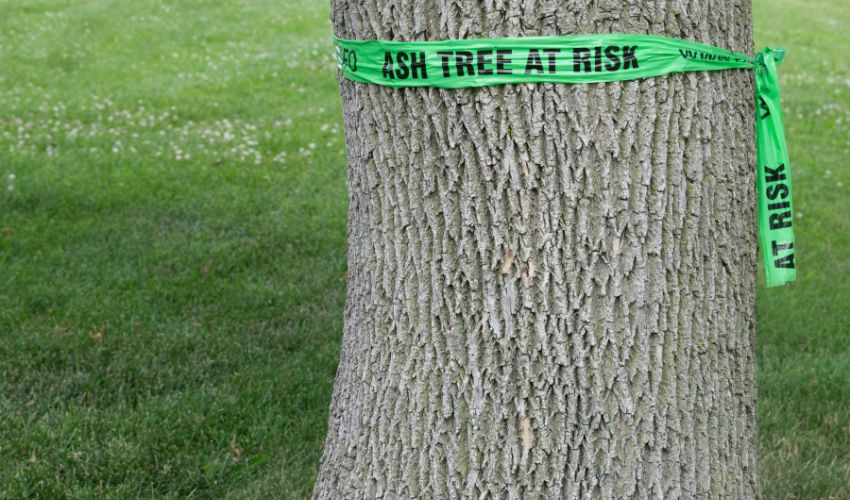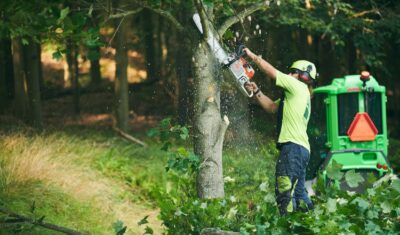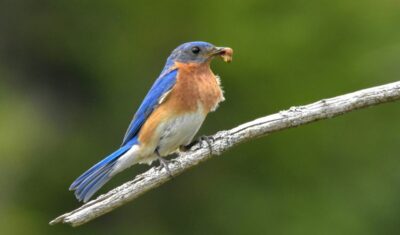Did you know that the invasive emerald ash borer (EAB) is now the most destructive forest pest in the US? This wood boring beetle, originally from Asia, was first discovered on US soil in 2002 in Michigan. Today, EAB kills or harms tens of millions of ash trees in North America every year.
It is present in 36 states, including our home of Ohio. In fact, Ohio is one of the most heavily affected states in the country, with EAB detected in every Ohio county.
While that may sound like a lot of bad news, especially if you love the ash trees on your property, there is hope. EAB treatments are available, making it possible to save ash trees that have already fallen victim to EAB (if caught early enough). If you want to prevent an EAB infestation, or save a tree already affected, then keep reading to find out how.
Are Emerald Ash Borers Really That Bad?
Yes, EAB is a destructive, relentless pest that can single handedly wipe out millions of trees per year. Though these wood boring beetles can fly and spread naturally, they are predominantly spread with human assistance, such as the transportation of firewood.
DON’T MOVE FIREWOOD! EAB is one of the primary reasons that firewood should not be transported more than a few miles from where it was harvested. Instead, you should buy it or harvest it locally, or buy certified heat-treated firewood.
As an invasive species, these beetles can do far more damage than most local pests. Our native ash trees haven’t developed natural defenses against these pests and most of our native predators don’t prey on EAB, allowing their population to multiply uncontrollably.
Learn more about Emerald Ash Borer in Northeast Ohio
Why Is EAB Treatment Difficult?
One of the problems is that early detection of EAB infestation is difficult. Adult EAB beetles will lay eggs in the crevices of bark on ash trees. When the larvae hatch, they burrow into the wood where they start feeding. The feeding is what damages and ultimately kills the trees, as they feed on the sensitive inner bark and phloem of the tree, cutting off the movement of water and nutrients throughout the tree.
The hatching and feeding all take place underneath the bark. There are no visual signs that a tree is infected, often until the damage is extensive and the tree is at risk of death.
EAB is a threat to any ash tree, regardless of health, size, or age. The larvae attack and kill all species of true North American ash. This includes the green, white, and black ash as well as varieties like the Patmore, Autumn Purple, and Marshall’s Seedless ash.
How You Can You Tell If Emerald Ash Borers Are Destroying Your Tree
EAB detection is difficult early on. As more and more damage is done, visual symptoms of EAB include:
- Canopy thinning and branch dieback, usually starting from the top of the tree
- Small branches sprouting from the base of the tree
- Bark splitting and turning a pale blonde color
- Zigzag tunnels under the outer bark layer
- D-shaped exit holes in the bark, about ⅛ inch across
- Woodpeckers frequently pecking at the tree
The good news is that EAB treatment options are available. If you start to notice some or all these symptoms on your ash tree, you may be able to save it from further damage.
Should You Use an EAB Treatment or Remove Your Ash Trees?
Before trying an EAB treatment, you’re probably wondering if it’s worth it, or if you should just remove all ash trees on your property. If you aren’t seeing extensive damage, crown thinning, and bark splitting in your existing ash trees, it may be worthwhile to keep the trees. This is especially true if you value the trees, if they provide shade, or if they are especially large.
But as ash trees suffer more and more damage from emerald ash borer larvae, they get weaker and weaker. When you start to notice branches dying and falling, the structural integrity of the tree may be at risk and removing it will usually be the best option.
Keep in mind that removing a healthier tree will be more cost-effective than removing a dead, brittle tree. So, if you don’t plan on treating your ash trees, consider removing them early on, before they weaken and become dangerous. If you have weak or damaged ash trees, consider removing them before the severe weather season in Northeast Ohio to minimize the risk of serious damage or injuries if the trees fail during a storm.
When to Remove EAB-Infested Ash Trees
How do you know if it’s best to remove an ash tree that’s been attacked by EAB? Here’s a general rule of thumb:
- If more than 30% of the canopy has been killed or is in severe decline before treatment has started, the tree is unlikely to fully recover. Consider removing the tree quickly.
- If less than 30% of the canopy has thinned, then starting EAB treatment can likely lead to a recovery. Consider keeping and treating the tree.
However, it can be difficult to tell how much damage has really been done by the borers. The best thing to do is get a free inspection and tree service estimate from a local, certified arborist that specializes in tree health issues. Here in Northeast Ohio, the team at Independent Tree can help you determine the best course of action for your ash trees, and potentially save your trees from death or removal.
EAB Treatment Options
So, what are the best EAB treatments you should try if you have infested ash trees on your property? Here are the four primary methods for treating trees that have been attacked by EAB.
1. Trunk Injection
Trunk injections are best left to professional plant health care specialists. An ODA-licensed applicator will drill through the outer layer of bark into the delicate sapwood and inject special insecticides where they are needed most, since this is where EAB larvae eat and cause damage.
This is the most effective method for controlling EAB. The insect control is taken up very quickly into the vascular system of the tree. Most often, the tree experiences protection from EAB within a few days of application.
Benefits of trunk injection:
- There is no spraying of insecticides into the air, the soil, or onto nearby plants.
- Best option for trees with shrubs or flowers near the base
- Best option for mature trees, as other methods may prove ineffective
- When properly administered, this treatment may only need repeating every 1-3 years, potentially saving money on treatment over the long term
- Periodic trunk injections are much more affordable than tree removal
Drawbacks of trunk injections:
- These treatments tend to be more expensive upfront, though less frequent applications can lead to savings over long periods.
2. Soil Drench
Soil drench treatments are applied to the soil at the base of the affected ash trees. Most products are either liquid or solid granules that are watered into the soil where the trees can take up the insect control through the roots and circulate it throughout the tree.
Benefits of soil drenching:
- These can be applied by licensed tree care professionals or property owners, though are shown to be more effective when applied by professionals.
- Works best on small to medium-sized trees.
- Specialized tools are not necessary for application.
- No damage is done to the bark of the tree.
Drawbacks of soil drenching:
- Soil drenches typically need to be done once a year.
- Not effective on very large ash trees.
- Leaching can occur, and the insecticide can be taken up by nearby plants, which can harm beneficial insects and pollinators.
3. Bark Spray
This option is also best left to professional tree care specialists. A licensed pesticide applicator will spray the outer bark on the lower portion of the tree. The insecticide penetrates the bark and moves systematically throughout the tree to fight off EAB. These treatments typically kill the larvae once they hatch, before they start eating away at the inner bark.
Additional spray products are available that kill EAB adults, helping to prevent them from laying eggs. Products that target adult beetles won’t kill larvae that are already feeding under the bark.
Benefits of bark spray:
- Insect control can be absorbed and circulated throughout the tree quickly.
- Certain applications are available that can kill adult beetles and prevent them from laying eggs.
Drawbacks of bark spray:
- When spraying the solution, wind can carry it onto nearby plants, potentially harming beneficial insect populations elsewhere.
- Bark spray treatments are typically applied once a year.
< Image 7 >
4. Tree Removal (And Replacement)
As a last resort, if too much damage has been done by EAB, it may be best to remove the tree altogether. The good news is that EAB can be eliminated from your property with this method. The bad news is that you may lose an important shade tree in your yard.
When a professional tree removal team removes the affected tree, they can likely remove the stump for you as well. That way, you can plant a new tree or trees nearby. Considering that EAB is already in your area, it would be best to plant other species. If planting multiple trees, consider planting a diverse selection, to limit the potential risk of insect damage in the future.
If you’re located in Northeast Ohio, the team here at Independent Tree can even replant new trees for you, from small saplings to large, mature trees. We can recommend the best trees depending on your location, soil type, light requirements, and watering needs to ensure successful, healthy trees for many years to come.
Best Time to Apply EAB Treatments
The best time to apply EAB treatments will depend on the type of treatment you are using.
- For trunk injections, the best time for application is when ash trees are most actively growing, from mid-May through June. This allows the insect control to circulate throughout the tree before peak hatching, which can occur between June and August.
- For solid drenching, the best time for application is in early spring. Specific solutions may specify the ideal season to apply, depending on your location.
- Studies have shown that fall applications tend to be less effective than spring applications.
Tips for Preventing EAB Problems
Once you confirm that EAB is present in your area (within 15 miles of your property), you can and should preemptively treat your ash trees to prevent damage and ensure strong, healthy trees for years or decades to come.
Other than that, the best thing you can do to help delay EAB infestation is to avoid bringing wood to your property. Transporting firewood or other wood sources could potentially introduce EAB or other harmful pests to the plants and trees on your property.
Call Independent Tree Today to Treat Your Ash Trees
If you’re in northeast Ohio, then your ash trees are already at risk of EAB. If left untreated, EAB can wreak havoc on your ash trees, killing them in a few years without you realizing it. When this happens, tree removal is the only option, as trees killed by EAB are extremely unsafe to leave on your property.
The good news is that the tree and plant health care experts at Independent Tree can help protect your ash trees. If you have one or more ash trees on your property and want to know if treatment or removal is right for you, then fill out this form to schedule a free inspection and tree care estimate today. Alternatively, you can call us at 440-564-1374 to set up a site visit and protect your ash trees today.
WORRIED ABOUT EMERALD ASH BORER?
As temperatures rise in spring and the adult beetles begin to emerge from infested ash trees, it's time to apply preventive treatments to healthy ash trees to protect them from this destructive pest. Don't wait until it's too late to schedule a treatment application and save your trees.Recent Articles
Topics
About The Author

STAY IN THE LOOP
WITH OUR
LATEST UPDATES
"*" indicates required fields
